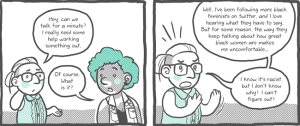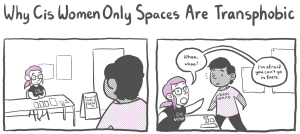Kat: This video is part of a series for Everyday Feminism, a website dedicated to helping you breakdown and understand everyday oppression.
2015 has been an amazing year for the LGBTQIA+ community: With the national passing of marriage equality and the growing representation of trans people in film and television, I think it’s fair to say that while we still may have a long way to go, we’ve come very far.
But in order to understand how far the LGBTQIA+ community as come, we have to understand how things used to be.
At the turn of the 20th century, the low rent and ethnic diversity of Greenwich Village, New York made it a haven for artists of all kinds. The Village, as it’s called, is in the lower part of Manhattan between Houston and 14th Streets and from the Hudson River to Broadway. Non-conformity was en vogue, radicalism was tolerated, and experimental theater thrived alongside large Broadway productions.
On Screen Text: Schools dedicated to art and sociology were built, and art museums and galleries were erected to help preserve the art that was very specific to the Village. It quickly became a bohemian enclave, and artists such as Martha Graham and Cole Porter started their careers in the village.
Kat: However, while the Village flourished, the state of New York was struggling to keep up. Sodomy laws made homosexual acts illegal, and they overwhelmingly targeted homosexual men, who were then referred to as homophiles.
On Screen Text: The word “homophile” or “homophilia” refers to a range of positive attitudes and feelings toward homosexuality or towards homosexual individuals and their orientation. It is an exact opposite term for homophobia.
Kat: Sodomy laws in New York have been consistently reformed since the 19th century, and by the 1950s, the punishment for sodomy had been reduced to a misdemeanor.
On Screen Text: In the 19th century, sodomy laws in New York were reformed. The punishment for sodomy in 1801 was life in prison, and by 1892, it was reduced to 20 years maximum. By the 20th century, the New York Police started to raid well-known gay establishments. Several bathhouses were raided, and several men were arrested for lewd behavior. By the 1940s, a medical journal called the Journal of Criminal Pyschopathology described the lobotomization of a gay man who was convicted of sodomy. In the 1950s, sodomy laws were reformed once again to reduce the punishment to a misdemeanor.
Kat: However, anti-gay policies and police raids of known gay establishments were still commonplace. The Mattachine Society is the earliest homophile organization in the United States. In 1966, the New York Mattachine Society hosted a sip-in at the Julius Bar on West 10th Street in Greenwich Village to protest the New York State Liquor Authorities’ anti-gay laws.
The law stated that it was illegal for homosexuals to congregate and to be sold alcoholic beverages. These laws resulted in the closing of several gay bars in New York, and in order for them to stay afloat, they had to rely on paying bribes to the police and the mafia. The Mattachine Society’s sip-in led to the end of the SLA laws, and there was a shift in the landscape of New York, and people began to express their sexualities and genders more openly.
However, the police and the fire department did not comply with the change of these laws, and several gay bars were still raided. While there were many legal gay bars selling alcohol, there were also places like the Stonewall Inn that were technically illegal and unlicensed.
The Stonewall Inn was known as a bar that really no one liked, but everyone frequented. It was where you went if you were too young or too poor to go anywhere else. It was a seedy little bar with no fire exits, no plumbing, and watered down liquor. Stonewall was a haven for homeless queer runaways, and it was one of the few places where you could go and express yourself freely in the Village.
Not only were there liquor restrictions, but you also couldn’t be seen even appearing to be in a homosexual relationship. That meant dancing was out of the question, but Stonewall was known to have the best dance floor in town. Drag queens ran the jukebox, and the crowd was working-class people of various genders, racial backgrounds, and sexual orientations.
One of most well-known patrons was Greenwich Village icon, Marsha P. Johnson, a Black drag performer, sex worker, and trans woman. Her close friend was Sylvia Rivera, a 17 year old Puerto Rican trans woman who was also a sex worker who regularly performed drag at the Stonewall Inn.
Storme DeLarverie could also be found in the dingy bar at 53 Christopher Street. She was a mixed black woman, drag king, and self-identified dyke who was often referred to as “the guardian of the lesbians in the Village.”
Miss Major Griffin-Gracy was a community leader for transgender rights, specifically for trans women of color. Most bars at the time denied entry to trans women, but as Miss Major established herself in the community, she no longer had to explain herself.
Stonewall was run by the mafia and relied on police bribes to keep the regular raids at bay.
On Screen Text: These raids became commonplace, and a system was established. Martin Duberman states in his book, Stonewall, that the sixth precinct took around 2,000 dollars in cash weekly.
Kat: Sometimes, however, the bars would be raided because they wanted a larger paycheck. And Seymour Pine was a Deputy inspector with the NYPD who was determined to have the bar closed down.
On June 24, 1969, he raided the bar and arrested several of the personnel and confiscated the alcohol. The bar’s owner had yelled at him defiantly that they would be open again tomorrow. On June 28, he returned on Saturday morning around 1AM with a search warrant with representatives of city and federal agencies to observe the raid.
That night, Marsha was celebrating her birthday with Sylvia, and she was disappointed at the lackluster turnout for her celebration. When the police entered, Sylvia shrieked, believing that she had forgotten her ID, but her friend Gary had brought it with him.
The way that these raids went was that generally, they’d examine the IDs of all the patrons. Everyone would line up and present their IDs for examination. The police would try to catch the patrons on absolutely anything. A common infraction that specifically targeted trans people and drag performers was the rule that you had to have at least four pieces of gender appropriate garb.
Sylvia was nervous, but she wasn’t expecting any harassment. After all, she only had a little bit of makeup on. The police came and grabbed her ID out of her hand and asked her with a smirk on his face if she was a boy or a girl. It was at that point where Sylvia had had it and almost swung on an officer, but was held back by her friend Gary.
The patrons of the Stonewall Inn had become so accustomed to these raids that they were taking them in jest. As drag queens, some of the more colorful patrons, left, they began to strike poses in front of the bar for the people passing by.
But when a paddy wagon pulled up and the police started moving arrested patrons into it, the mood changed. People started pushing the paddy wagon, and the police yelled at them to get back. The mood kept shifting, and there was a foreboding presence like something was about to happen.
The definitive turning point of the night is when Storme DeLarvarie was taken out of the bar and put into a control wagon after fighting with four police officers. She screamed to the onlookers, “Why don’t you do something?” desperately wondering how clear acts of police brutality could go without uproar.
From that point, the crowd erupted. Marsha P. Johnson is said to have been the first person to throw a shot glass at police officers. Some Stonewall veterans refer to that as “the shotglass heard around the world.”
Syliva Rivera is said to have thrown a bottle at police officers. Bar patrons and the people in the community started pelting the police with stones, and civil disobedience erupted into Christopher Street.
Most famously, a kick line of drag queens formed and sung “We are the Stonewall girls, we wear our hair in curls, we don’t wear underwear, we show our pubic hair” before assaulting officers with any piece of the bar they could find.
The Stonewall Riot meant many things to many people. People that were there describe it as an event that allowed them to finally vent their anger. Street kids who had nothing to lose and gender variant people were largely responsible for the uprising.
Miss Major was later arrested after being intentionally knocked out by a police officer to avoid further injury – a strategy she had learned from other queens. The Stonewall Riots continued for a few days after that night and sparked the foundation for the fight for LGBTQIA+ rights and activism.
Sylvia Rivera and Marsha P. Johnson went on to create STAR, Street Transvestite Action Revolutionaries, a group dedicated to helping homeless drag queens and trans women. A militant group called The Gay Liberation front was formed and stood in contrast to the non-violent approach of The Mattachine society.
On Screen Text: It was also the first organization to use the word “gay” and is attributed for the contemporary use of the term.
Kat: Miss Major became an advocate for incarcerated transgender women, and to this day still advocates for that cause. Storme DeLavarie became an active member of the Stonewall veterans and had a film about her life released in 1987 about her life in America’s first integrated drag revue.
The Stonewall Riots were celebrated every year on June 28th on the Christopher Street Liberation Day. And this became the start of what we now call Gay Pride.
Four years after the riots, Sylvia Rivera got on stage during the Gay Liberation Rally during Gay Pride to represent STAR. She was heckled and booed while trying to speak out about trans women and gender variant individuals who are often targeted for sexual violence in prison. While she gave an iconic speech, she left feeling disempowered, and she slipped away from activism for the next twenty years.
While accounts of the events that evening vary, there is one consistent part of the narrative: that trans women, drag queens, and people of color played a large part of the events that evening.
In September of this year, a movie directed by Roland Emmerich and written by Jon Robin Baitz about Stonewall will be in theaters. And the star of the film isn’t Sylvia or Marsha, Storme or Miss Major, but a fictional cis, white male protagonist named Danny Winters who is credited as the man who threw the first brick at Stonewall.
In part two, I’ll be giving my criticism of that trailer – and they may or may not be what you think.
So for now, Kat Blaque for Everyday Feminism, signing out.




















